“Hey! Here’s a giant, cold swamp! Wanna live here?”
“Hmm”¦ seems hard, but”¦ okay!”
Against All Odds
Only people as smart and organized as the Dutch 1Dutch = people who live in the Netherlands, which is sometimes called Holland would even consider attempting to settle in a windswept, waterlogged land.
For two thousand years now, the Dutch and their ancestors have been toiling away. They build holding pens 2aka canals for vast quantities of water and construct quintessential windmills to move the water to the designated area.
There’s a Dutch saying that encapsulates the madness: ‘God made the earth but the Dutch made Holland.’ 3according to ryansavage.net
A few months ago, I finally got around to reading Windfall: The Booming Business of Global Warming. If you have any interest in who is benefiting from the current and predicted climate, or who is going to be totally screwed (hint: probably not you), or any investing proclivities, add it to your book stack.
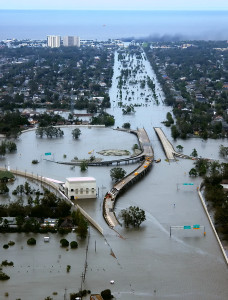
I bet New Orleans residents wish the area had been colonized by the Dutch instead of the French! ** photo: wikipedia
Among many things, the book discusses how rising seas create booming business for the Dutch. Their hard won brilliance, cultivated over centuries, is suddenly in high demand. Coastal cities like Miami, New York, Calcutta, Shanghai, Mumbai, Tokyo, Hong Kong, Bangkok, New Orleans, and Boston are getting veeerrrrrrrrry interested in how you do this whole water-controlling thing.
Certainly the Netherlands 4aka Holland, where 60% of the population lives below sea level, could be the sensei these cities seek. If not for Dutch engineering feats, more than 50% of their country would be flooded with every high tide, wet season, or permanently. 5according to Haarlemmermeer Cruiquius Museum literature
Recipe for Success
Here’s how the Dutch came to thrive in a seemingly impossible environment:
- At first, they got rid of sea-side lakes to have access to the land under the water. How? First build a wall between the lake and the sea, since the lake and ocean are normally connected at high tide. Then, put a one-way door in the wall that opens toward the ocean. During low tide, the water in the lake flows out the door. When the tide begins to rise and flow inland, the pressure pushes the door — the only hole in the barrier between lake and sea — tightly closed until the next low tide.
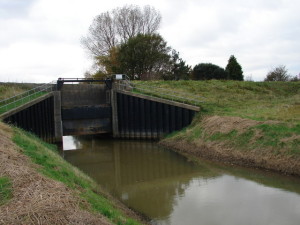
I couldn’t fine a picture of the more primitive sluice gates (i.e. one-way-doors) that were originally used, but this gives a good general idea of what the first lake draining endeavors looked like. ** photo: wikimedia
- Once the salty lake had been drained, subsequent rains rinsed away the salt. After awhile, the drained lake (called “polders” in the Netherlands), became fertile!
- But when a newly drained patch of land is below sea level, the water table must be vigilantly maintained lest the land fill with water faster than it can be drained. There are also lots of parts of the Netherlands that were covered in water that aren’t next to the sea — i.e. no option of a handy-dandy one way gate in a barrier wall to assist with draining. Enter the windmills for which the Netherlands is famous.
- In inland situations, giant canals were built to carry the water to the sea. Usually a circular canal was built around the lake’s perimeter with an offshoot headed for the sea. Then windmills were used to pump water out of the lake and into the canals until it was dry. The windmills were always needed to make sure the lakes didn’t fill back up.
- The windmills are unique and have become a Dutch icon because of local conditions. Low, flat land coupled with a steady stiff breeze meant the wings or sails didn’t need elevated far off the ground. A double bonus: the wings could be adjusted easily and without a ladder. The windmills are attached to mechanisms that scoop up the water – either a scoop wheel or an Archimedean screw.

Windmills can lift water up to 6 ft. Then another one is needed to lift the water the next 6 ft. Rather than the water moving the scoop wheel, as pictured, the windmill turns the wheel so it scoops the water up. ** photo: wikimedia
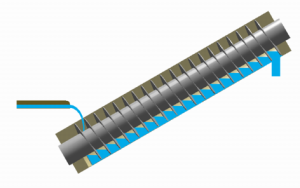
The Archimedean screw makes it possible for a windmill to lift water up to 15ft – an elevation usually requiring three windmills with scoop wheels. ** photo: wikimedia
- To stabilize the ground, they drove piles to support buildings. It mostly worked. Remember that everyone is so packed in, that when a building sinks in one direction, a house is usually there to catch it!
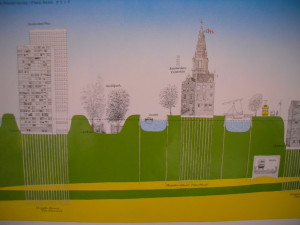
Fascinating cross section of Amsterdam, demonstrating locations at and below sea level as well as what goes into the wet ground to support buildings.
Peril Promotes Progress
Draining small lakes is easy. Big lakes? Not so much. In the 1800’s one lake, originally prized for fishing and transport opportunities, got so big it became dangerous. When everything is at or below sea level, it doesn’t take much extra water to tip the balance. Couple that with people constantly removing peat from the shoreline for fuel, and the lake started taking buildings and villages. The biggest water problem the Netherlands had ever seen had to be faced..
To drain the lake, the king made an unpopular, risky decision to try out the newest technology: steam engines. It took some growing pains, but his decision eventually proved successful. The lake, Haarlemmermeer, was only five meters deep, but it still took more than three years of three pumps working 24/7, draining 132,000 liters 648,000 gallons in one stroke 7each pump removed 64,000 liters(16,000 gallons) per stroke – 132,000 is the total between all pumps, to drain the lake.
One of the pumps was preserved and turned into a museum 8called Cruquius, which I had the geeky glee of visiting when I was in Amsterdam. How could a defunct, ancient water pump be even the tiniest bit interesting? Oh, I am *so* glad you asked.
- Okay, first of all, let’s make sure you know how a basic pump works. I’ll let you do your own googling, but essentially an empty space fills with water, the water gets moved elsewhere which creates an empty space again”¦ repeat, repeat, repeat.
- They used brand-new technology (a steam-powered engine) to make all the pump parts move. Because there were so many pumps (8) and only one engine, they arranged the pumps in a circle, making for a pretty awesome looking building. 9Nerd-speak: the pumps were operated in parallel by a single engine, so the building was made circular.
- Steam powered engines get their energy from the way water freaks out when it gets hot. Think of a covered pot of boiling water — the lid is always bouncing and steam sneaks out every chance it gets. When you trap steam, it gets desperate to escape: it pushes really really hard on whatever is trapping it.
- So basically, they made a place to trap steam, and then put a giant weight on top. The steam, in its desperation to escape 10nerd speak: expand, pushed the weight up into the air. Then gravity caused the weight to fall. The falling weight acted like a team of horses, pulling the pump parts that lifted the heavy water.
- How big was the weight? Big. So big. 85,000 kilos! 93 U.S. tons! 187,393 pounds! 11Nerd version: Each of the eight pumps moved 8,000 liters in a single stroke. Since a liter weighs a kilo, each pump moved 8,000 kilos of weight. Multiply by 8 pumps and you get 64,000 kilos of weight needing moved. Therefore the weight pushed by the steam needed to be even bigger.
- The two coolest (nerdy!) things about the system’s design: 1) The weight comes to a stop at the top thanks to fascinating calibration — basically the steam loses pressure as it expands, pushing less and less hard until the weight stops, 2) as the weight comes to a stop, it allows steam to escape into other chambers underneath the weight. That means the steam can still support the weight differential 1285,000 kilo weight vs. 64,000 kilos of water being moved as it falls, allowing the whole pump to be precisely tuned. Cool!
However, like windmills, this rad steam pump’s job is never done. As the Netherlands population grew and agricultural needs changed, the water table had to be kept within stricter limits with shorter, more intense pumping periods. 13paraphrasing Haarlemmermeer Cruiquius Museum literature. More modern pumps have taken over, allowing Cruiquius to retire to a life of leisure and exhibitionism. Geeks of the world delight! ♣
References
| ↑1 | Dutch = people who live in the Netherlands, which is sometimes called Holland |
|---|---|
| ↑2 | aka canals |
| ↑3 | according to ryansavage.net |
| ↑4 | aka Holland |
| ↑5 | according to Haarlemmermeer Cruiquius Museum literature |
| ↑6 | 48,000 gallons |
| ↑7 | each pump removed 64,000 liters(16,000 gallons) per stroke – 132,000 is the total between all pumps |
| ↑8 | called Cruquius |
| ↑9 | Nerd-speak: the pumps were operated in parallel by a single engine, so the building was made circular. |
| ↑10 | nerd speak: expand |
| ↑11 | Nerd version: Each of the eight pumps moved 8,000 liters in a single stroke. Since a liter weighs a kilo, each pump moved 8,000 kilos of weight. Multiply by 8 pumps and you get 64,000 kilos of weight needing moved. Therefore the weight pushed by the steam needed to be even bigger. |
| ↑12 | 85,000 kilo weight vs. 64,000 kilos of water being moved |
| ↑13 | paraphrasing Haarlemmermeer Cruiquius Museum literature |

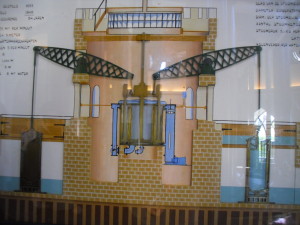




2 pings